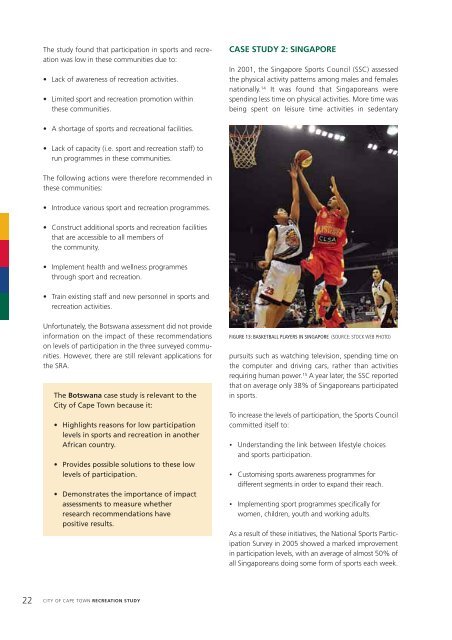Recreation Study
Recreation Study
Recreation Study
- No tags were found...
You also want an ePaper? Increase the reach of your titles
YUMPU automatically turns print PDFs into web optimized ePapers that Google loves.
The study found that participation in sports and recreationwas low in these communities due to:• Lack of awareness of recreation activities.• Limited sport and recreation promotion withinthese communities.CASE STUDY 2: SINGAPOREIn 2001, the Singapore Sports Council (SSC) assessedthe physical activity patterns among males and femalesnationally. 14 It was found that Singaporeans werespending less time on physical activities. More time wasbeing spent on leisure time activities in sedentary• A shortage of sports and recreational facilities.• Lack of capacity (i.e. sport and recreation staff) torun programmes in these communities.The following actions were therefore recommended inthese communities:• Introduce various sport and recreation programmes.• Construct additional sports and recreation facilitiesthat are accessible to all members ofthe community.• Implement health and wellness programmesthrough sport and recreation.• Train existing staff and new personnel in sports andrecreation activities.Unfortunately, the Botswana assessment did not provideinformation on the impact of these recommendationson levels of participation in the three surveyed communities.However, there are still relevant applications forthe SRA.The Botswana case study is relevant to theCity of Cape Town because it:• Highlights reasons for low participationlevels in sports and recreation in anotherAfrican country.• Provides possible solutions to these lowlevels of participation.• Demonstrates the importance of impactassessments to measure whetherresearch recommendations havepositive results.FIGURE 13: BASKETBALL PLAYERS IN SINGAPORE (SOURCE: STOCK WEB PHOTO)pursuits such as watching television, spending time onthe computer and driving cars, rather than activitiesrequiring human power. 15 A year later, the SSC reportedthat on average only 38% of Singaporeans participatedin sports.To increase the levels of participation, the Sports Councilcommitted itself to:• Understanding the link between lifestyle choicesand sports participation.• Customising sports awareness programmes fordifferent segments in order to expand their reach.• Implementing sport programmes specifically forwomen, children, youth and working adults.As a result of these initiatives, the National Sports ParticipationSurvey in 2005 showed a marked improvementin participation levels, with an average of almost 50% ofall Singaporeans doing some form of sports each week.22 CITY OF CAPE TOWN RECREATION STUDY


